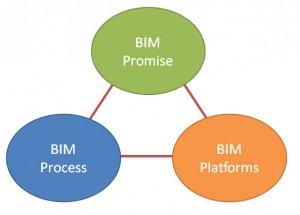I talk a lot about BIM.
I hear others talking a lot about BIM. I hear and read from experts, pendants, gurus and more about BIM. There is a lot of conversation going about BIM.
I have noticed that the conversations surrounding BIM tend to fall into three categories. I have shown them below as being interrelated and I think they are. They are often intertwined, overlapping and subordinate to each other on a rotating basis.
The three categories for these conversations are BIM Promise, BIM Process and BIM Platforms
Since they overlap and are interwoven, there tends to be confusion related to what is being talked about in any given conversation. Some conversations remain strict in there scope and others move from one area to another.
Here is how I define the boundaries of each area.
BIM Platforms
These conversations center on the use of the various tools available and how to use these tools.
There are so many tools coming into the marketplace that it is hard to keep up. The ones that are out there soon will be joined by many more. The conversations about what is out there to use and when it is used are included in this area.
Using BIM tools is a learning curve process. You need to know how to use the tools. There are blogs-a-plenty that tell you what buttons to push or which switches to flip or where to store your information. There are websites that outline training. There are training outfits that provide that training. There are site to complain about the lack of the existing BIM tools.
So this area would include all conversations that discuss the technology and tools that are used on your projects. Think of it as talking about your saws, hammers, nails and levels that are used in building. This is about a new bricklayer learning how to lay each brick.
BIM Process
These conversations focus on the process of using the tools to get the job done. It slides outside of the software you are using and gets into project management, cost estimating, engineering calculations, accounting, billing and collections.
Project Management needs to think through how BIM is changing the landscape of their processes. The processes are changing as they relate to estimating workloads and distributing tasks. You can no longer think in terms of CAD when mapping out the project work plans. You cannot slice up the project workload the way you did in CAD.
Cost estimating and calculations will change when your models get more intelligent. With more information going in, more can be taken out. Accounting practices and project billing will need to change as project labor hours get pushed to the front of the project. This may be a larger concern if the project gets shelved after SD or DD phases. It will be tough to convince a client that the amount of hours you expended need to be paid if they did not realize the shift in manpower loading brought about by BIM.
Think of this area of conversation like the construction site Foreman’s discussions of orchestrating trades (who use the tools outlined above), the lay down areas for construction, staging and time lining the project. This is about bricklayers constructing a building.
BIM Promise
Conversations about the grand future of BIM fall into this area. These are the conversations that set the stage for product development, project delivery and more. This is a discussion about tomorrow, not about today.
In the early days of BIM (not so long ago), this was the conversation that everyone was in. It was all about the future. It was about what BIM would bring us and the change that was just around the corner. This conversation outpaced the development of the tools in the beginning. The tools are starting to catch up, but this conversation keeps moving ahead.
This conversation was captured by the marketing hype of the tool developers. At some point in time you will have to separate the reality from the hype. Don’t let the marketers pitch something about tomorrow that does not take into account the realities of today.
Talk like this is akin to the conversations that a building may have with an owner about the skyscrapers that might be built using the processes of construction and the advanced tools of the trades. It allows people to dream. This is about a bricklayer union building a grand cathedral.
What does it mean to me?
You need to know when each conversation is starting and ending. Like I said, they tend to wind themselves together. If you are answering a question that you think is about BIM Platform (what can we do now?) and the other person is talking BIM Promise (What can BIM do?). They will be frustrated that you are thinking too small. If they are asking you about process and you answer with promise, then they will expect you to deliver on that promise.
So pay attention and clarify your answers (We can do this right now, but in a year we can also do this) so that everyone knows what is being discussed.



Leave a Reply